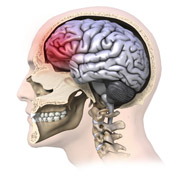Research and Innovation, UNL Office of

Center for Brain, Biology, and Behavior: Faculty Publications
Document Type
Article
Date of this Version
2012
Citation
Neurology 78 (May 29, 2012), pp 1777-1784.
PMID: 22592370
PMCID: PMC3359587
DOI: 10.1212/WNL.0b013e3182582fe7
Abstract
Objective: To determine whether exposure to repetitive head impacts over a single season negatively affects cognitive performance in collegiate contact sport athletes.
Methods: This is a prospective cohort study at 3 Division I National Collegiate Athletic Association athletic programs. Participants were 214 Division I college varsity football and ice hockey players who wore instrumented helmets that recorded the acceleration-time history of the head following impact, and 45 noncontact sport athletes. All athletes were assessed prior to and shortly after the season with a cognitive screening battery (ImPACT) and a subgroup of athletes also were assessed with 7 measures from a neuropsychological test battery.
Results: Few cognitive differences were found between the athlete groups at the preseason or postseason assessments. However, a higher percentage of the contact sport athletes performed more poorly than predicted postseason on a measure of new learning (California Verbal Learning Test) compared to the noncontact athletes (24% vs 3.6%; p < 0.006). On 2 postseason cognitive measures (ImPACT Reaction Time and Trails 4/B), poorer performance was significantly associated with higher scores on several head impact exposure metrics.
Conclusion: Repetitive head impacts over the course of a single season may negatively impact learning in some collegiate athletes. Further work is needed to assess whether such effects are short term or persistent.
Included in
Behavior and Behavior Mechanisms Commons, Nervous System Commons, Other Analytical, Diagnostic and Therapeutic Techniques and Equipment Commons, Other Neuroscience and Neurobiology Commons, Other Psychiatry and Psychology Commons, Rehabilitation and Therapy Commons, Sports Sciences Commons


Comments
Copyright © 2012 by AAN Enterprises, Inc. Used by permission.